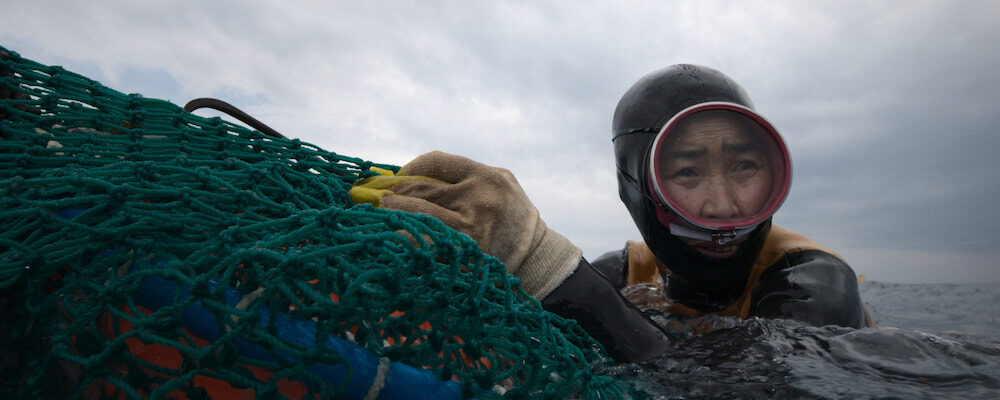Sue Kim’s Fascinating ‘The Last of the Sea Women’ Chronicles the Free-Diving Tradition of South Korea’s Haenyeo
Alci Rengifo
They are known as haenyeo or sea women, and for centuries have dived into the waters off of South Korea’s Jeju Island to fish. There are only four-thousand of them left, many over 70 years old, and they are now facing major environmental changes. This is the instantly fascinating premise of Sue Kim’s “The Last of the Sea Women,” co-produced with Malala Yousafzai and Erika Kennair for Apple TV+. It is a good bet much of the audience that discovers this documentary will have never heard of the haenyeo before. Good documentaries serve the function of strong journalism, with a much more artistic eye. Kim’s way of profiling these impressive women holding onto their way of life plays like a classic sea adventure, though by the end, it becomes about environmental issues concerning us all.
“The story of the haenyeos is something I’d been thinking about for most of my life,” Kim tells Entertainment Voice. “I had actually encountered them as a young girl for the first time and they made a strong impression on me. I saw this community of women who seemed very tough and strong and fearless, and then I found out about their history of free diving and financial independence, at a time when many women didn’t have that.” Kim’s portrait of life on Jeju Island does seem to reveal a matriarchal society where men rarely interfere. The women on camera, the youngest in their 60s, remember being scoffed at by society when they were young divers. Some did marry, many are now widows. Their chosen life path is not an easy one and usually begins at around the age of 7, which is when haenyeos start learning how to deep dive without any oxygen tanks. A good haenyeo could make quite a decent living as recently as 20 years ago, depending on how much they would catch for the seafood market.
The same rules apply today except the haenyeos face two ominous realities: Fewer young people want to do their job and the waters around Jeju Island are becoming increasingly polluted and increasingly warm, both factors deeply impacting marine life. Kim saves some of the more urgent material for later, allowing us to have fun with her subjects as they share their stories with an impressively youthful vigor. It’s not a bad workout to spend decades swimming into the depths every day of your life. As the women remind us, their lives are at stake due to the dangers of their profession. One shares about a haenyeo found dead underwater, her arms bursting with catch. She was so desperate to grab as much sea urchin and conch as possible, she eventually drowned. Despite making a living as the goal, a wise haenyeo knows just how much seafood to harvest.
Not everyone in the younger generations is dismissive of the haenyeo way of life. Kim profiles Sohee Jin and Jeongmin Woo, two women in their 30s who live as haenyeos in a neighboring island. They make the profession look cool and sexy with YouTube and TikTok videos. Jin is a mother who left her soul-sucking corporate office job and never wants to do anything else other than free dive. After UNESCO added haenyeos to its Intangible Cultural Heritage List, fresh training programs have sprouted trying to entice younger Koreans to consider the work. One gets the sense this is a life meant for the natural adventurer. It is hard to imagine a haenyeo wanting to adapt to a conformist, big city lifestyle. Though, the aged haenyeos sound like sweet, traditional grandmothers when pestering Jeongmin, who is 31 and single, to find a good husband, even recommending one of their single grandsons.
The final section of “The Last of the Sea Women” takes on a universal importance. When the Japanese government decides it will begin slowly emptying collected water from the damaged Fukushima nuclear power plant into the ocean, the Jeju Island community panics. Despite the Japanese government claiming the water has been cleaned of dangerous radiation levels, environmental experts warn that the waters of neighboring countries and islands will suffer the consequences for years. Soon Deok Jang, one of the older haenyeo, briefly becomes the documentary’s main fixture when she travels to the Human Rights Council in Switzerland. Determined to give her community a voice, she learns broken English to plead against Japan’s actions. Sadly, such venues can become mere stages. The water dumping process at Fukushima officially began in 2023 and will take up to 30 years. Remember, here in the U.S., we share the Pacific with Japan. The issue of Fukushima is not just confined to our neighbors in Asia.
What stays with the viewer is the liveliness of “The Last of the Sea Women.” Kim, who also has a background in music, works with composer Jang Young Gyu to give her documentary the feel of beachy rock ‘n’ roll and folk sounds. They throw in some great needle drops like “Youngjeonggeori” by Ak Dan Gwang Chil. The aged haenyeos get transformed into real heroes. Trash from China and other big neighbors are also infesting the waters, yet they keep going. “I wanted to bring awareness to a global audience,” says Kim. “I wanted to show the real world impact of environmental disasters. So many times we can read these newspaper headlines and see, ‘oh, Japan is going to release this radioactive water,’ but we don’t see the real world effects it has. The real world effects tend to be felt most deeply in marginalized communities, communities that are not near the centers of power.”
“The Last of the Sea Women” begins streaming Oct. 11 on Apple TV+.

